|
|
|
ADVERTISEMENTS
|
|
PREMIUM
- HAPPY HOLIDAYS!
- Siliconeer Mobile App - Download Now
- Siliconeer - Multimedia Magazine - email-Subscription
- Avex Funding: Home Loans
- Comcast Xfinity Triple Play Voice - Internet - TV
- AKSHAY PATRA - Bay Area Event - Sat. Dec 6
- Calcoast Mortgage - Home Loans
- New Homes in Silicon Valley: City Ventures - Loden Place - Morgan Hill
- Bombay to Goa Restaurant, Sunnyvale
- Buying, Sellling Real Estate in Fremont, SF Bay Area, CA - Happy Living 4U - Realtor Ashok K. Gupta & Vijay Shah
- Sunnyvale Hindu Temple: December Events
- ARYA Global Cuisine, Cupertino - New Year's Eve Party - Belly Dancing and more
- Bhindi Jewellers - ROLEX
- Dadi Pariwar USA Foundation - Chappan Bhog - Sunnyvale Temple - Nov 16, 2014 - 1 PM
- India Chaat Cuisine, Sunnyvale
- Matrix Insurance Agency: Obamacare - New Healthcare Insurance Policies, Visitors Insurance and more
- New India Bazar: Groceries: Special Sale
- The Chugh Firm - Attorneys and CPAs
- California Temple Schedules
- Christ Church of India - Mela - Bharath to the Bay
- Taste of India - Fremont
- MILAN Indian Cuisine & Milan Sweet Center, Milpitas
- Shiva's Restaurant, Mountain View
- Indian Holiday Options: Vacation in India
- Sakoon Restaurant, Mountain View
- Bombay Garden Restaurants, SF Bay Area
- Law Offices of Mahesh Bajoria - Labor Law
- Sri Venkatesh Bhavan - Pleasanton - South Indian Food
- Alam Accountancy Corporation - Business & Tax Services
- Chaat Paradise, Mountain View & Fremont
- Chaat House, Fremont & Sunnyvale
- Balaji Temple - December Events
- God's Love
- Kids Castle, Newark Fremont: NEW COUPONS
- Pani Puri Company, Santa Clara
- Pandit Parashar (Astrologer)
- Acharya Krishna Kumar Pandey
- Astrologer Mahendra Swamy
- Raj Palace, San Jose: Six Dollars - 10 Samosas
CLASSIFIEDS
MULTIMEDIA VIDEO
|
|
|
|
|
NEWS DIARY | MAY
India May Borrow More in First Half of Fiscal Year | Earliest Evidence of Leprosy Found in India | Aila Kills 200 | Pak Bombing Kills 30 | UN Demands Lanka Probe | Curfew in Punjab | Maoists Invited to Join Govt | Aussie Cops to Visit
India May Borrow More in First Half of Fiscal Year
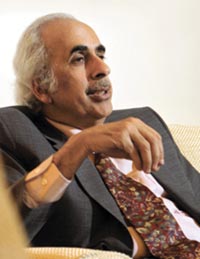 Ashok Chawla Ashok Chawla
India may borrow more than scheduled in the first half of the fiscal year as it “frontloads” some bond sales, Finance Secretary Ashok Chawla has said.
“The government is likely to borrow more in the first half of the fiscal year” as banks, the biggest buyers of government debt, have surplus cash to buy the securities, Chawla said in an interview in New Delhi May 27.
There’s no change in the nation’s borrowing plan for the fiscal year ending March 31 as of now and the government may revisit its debt sale program when Finance Minister Pranab Mukherjee presents his budget in July, he said. Government bonds slipped on concern rising supply will reduce demand for existing notes in the market.
Prime Minister Manmohan Singh’s government, which won a second five-year term recently, is borrowing more to fund three stimulus packages to revive growth in Asia’s third-largest economy, forecast by the central bank to expand at the slowest pace in seven years. Higher borrowing widened the budget deficit to 6 percent of gross domestic product in the year ended March 31, the most since 2001.
India plans to borrow a record 3.62 trillion rupees ($76 billion) in the current fiscal year, and estimates the budget shortfall at 5.5 percent of GDP.
The yield on the benchmark 6.05 percent note due February 2019 increased to 6.57 percent from 6.56 percent earlier, according to the central bank’s trading system.
The federal government on May 18 decided to increase debt sales for the month to 540 billion rupees from the scheduled 480 billion rupees. It also plans to raise 120 billion rupees at an auction scheduled between May 29 and June 5.
Fitch Ratings, which ranks India’s debt BBB-, its lowest investment grade, said May 14 that it expects the nation’s new government to step up spending to arrest slowing economic growth.
|TOP|
Earliest Evidence of Leprosy Found in India
Leprosy is one of mankind’s most ancient scourges, mentioned in writing from ancient India to the Bible to the Middle Ages. Now researchers have uncovered what they say is the oldest case of the disease yet found.
Analysis of a 4,000-year-old skeleton from India shows traces of leprosy, researchers reported May 27 edition of PLoS One, a publication of the Public Library of Science.
The skeleton was buried about 2000 B.C. at the site of Balathal, a large settlement in what is now Rajasthan, according to Gwen Robbins, an anthropologist at Appalachian State University in Boone, N.C.
Balathal thrived from about 3700 to 1800 B.C. While leprosy is infectious, it is relatively hard to catch, requiring prolonged association with someone who has the disease. It has only one other animal host, the armadillo.
Scientists have speculated that leprosy originated in India or Africa and may have spread from Asia to Europe with the returning army of Alexander the Great.
Previous skeletal evidence for the disease has been dated to 300 to 400 B.C. in Egypt and Thailand.
While leprosy is relatively easy to treat today, the World Health Organization estimates there were about 212,000 new cases worldwide last year, a rate that has been gradually falling. It is a bacterial disease affecting the skin and nerves, especially of the hands and feet.
Robbins’ team said the presence of leprosy at Balathal supports early texts that refer to the disease as early as 1550 B.C. in India and Egypt.
|TOP|
Aila Kills 200
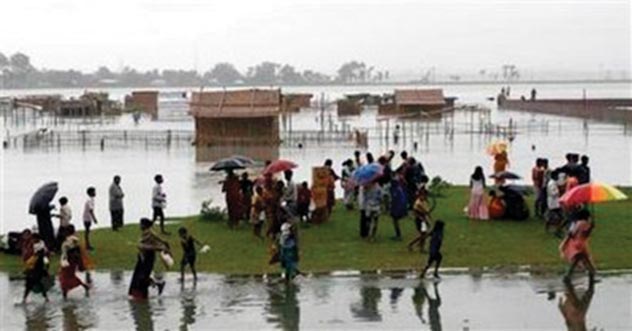
Flood-affected people move to safer places on the outskirts of Siliguri, West Bengal.
Nearly 200 people have been killed by a cyclone that ripped through Bangladesh and eastern India, while millions remained marooned by floodwater or forced to live in shelters.
The death toll in Bangladesh rose to more than 130 following recovery of dozens of bodies May 26, newspapers and private television channels said, while Indian officials said at least 64 people had died in West Bengal state.
Cyclone Aila slammed into parts of coastal Bangladesh and eastern India May 25, triggering tidal surges and flooding that forced people from their homes.
Officials in both countries said they feared the death tolls would rise although relief and rescue efforts were being intensified.
“Millions of people have been affected by the cyclone, with half a million in shelters and another half a million forced from their homes or were marooned,” a disaster control official, who asked not to be identified, told Reuters in Dhaka.
Officials in Bangladesh moved about 500,000 people to temporary shelters after they left their homes to escape huge tidal waves churned by winds up to 100 kph (60 mph).
Heavy rain triggered by the storm also raised river levels and burst mud embankments in the Sundarbans delta in the neighboring eastern Indian state of West Bengal.
“So far, we have got reports of 64 deaths in the state, including nine deaths in landslides in the Darjeeling hills on Tuesday,” West Bengal’s chief secretary Ashok Mohan Chakraborty told reporters in Kolkata.
In Bangladesh, the worst affected area was the Satkhira district, near the port of Mongla, where a local official said 31 bodies were found in one village.
“The situation here is alarming,” Mohammad Abdus Samad, deputy commissioner of Satkhira, told Reuters by telephone.
|TOP|
Pak Bombing Kills 30
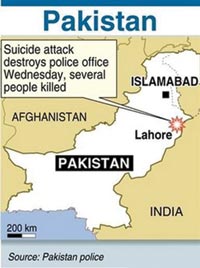 A suicide car bomber targeted buildings housing police and intelligence agency offices in eastern Pakistan May 27, killing about 30 and wounding more than 100 in one of the deadliest such blasts in the country this year, officials said. A suicide car bomber targeted buildings housing police and intelligence agency offices in eastern Pakistan May 27, killing about 30 and wounding more than 100 in one of the deadliest such blasts in the country this year, officials said.
The attack, which was followed by gunfire, was the third major strike in the city of Lahore in recent months, and it came amid worries of retaliation from Taliban militants facing a major Pakistani military offensive in the northwest.
Lahore is a major cultural metropolis near the Indian border, and assaults there have heightened fears that militancy in Pakistan is spreading well beyond the northwest region bordering Afghanistan.
No one immediately claimed responsibility for the bombing.
Raja Riaz, a senior minister in the Punjab province government, told reporters that about 30 people died. Fayyaz Ranjha, a senior health official, told state-run Pakistan Television that the attack had wounded 116 people.
The explosion was so powerful it sheared the walls off buildings in a main business district. TV footage from the scene showed injured bystanders while emergency workers carried at least one person covered by a blanket to an ambulance.
Police official Mohammed Ashfaq said it was a suicide car bomber, and that the attack occurred outside the office of the emergency police service in Lahore. TV footage showed the nearby office of the Inter-Services Intelligence agency also was damaged.
Ashfaq said gunshots were heard immediately after the blast. An AP reporter saw dozens of troops entering the damaged building of the spy agency to supervise the rescue work, while gunshots were also heard from inside the building even one hour after the blast.
|TOP|
UN Demands Lanka Probe
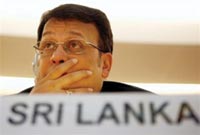 Sri Lanka Human Rights Minister Mahinda Samarasinghe listens during a Human Rights Council session at the United Nations headquarters in Geneva, Switzerland , May 26. Sri Lanka Human Rights Minister Mahinda Samarasinghe listens during a Human Rights Council session at the United Nations headquarters in Geneva, Switzerland , May 26.
The U.N.’s top human rights official demanded an independent investigation May 26 into atrocities allegedly committed by both sides in Sri Lanka’s civil war.
High Commissioner for Human Rights Navi Pillay told an emergency meeting of the Geneva-based U.N. Human Rights Council that tens of thousands of civilians had been killed or injured in intense fighting between the government and Tamil rebels since December. But a majority of the 47 countries on the council appeared unwilling to heed her appeal for a war crimes probe.
Pillay said the Sri Lankan government had an obligation to respect humanitarian law at all times, even when fighting terrorism.
“In no circumstances can the end justify the means,” Pillay said. “There are strong reasons to believe that both sides have grossly disregarded the fundamental principle of the inviolability of civilians.”
Sri Lankan Ambassador Dayan Jayatilleka said it was “outrageous” to suggest the government should be investigated along with the rebels, saying it was like asking the victorious allies of World War II to accept a war crimes tribunal for the atomic bombing of Hiroshima.
“Just name me one country in history anywhere in the world ... that would embrace such a suggestion,” Ambassador Dayan Jayatilleka told The Associated Press. “It’s outrageous. Sri Lanka has just prevailed over a notoriously fanatical and formidable army, the Tamil Tigers.”
Jayatilleka insisted the conflict was a domestic matter in which other countries had no right to interfere, and denounced the staging of the council meeting.
|TOP|
Curfew in Punjab
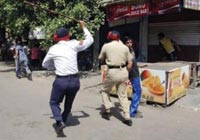 Police chase protesters after they tried to assemble in Amritsar May 26. Police chase protesters after they tried to assemble in Amritsar May 26.
Troops patrolled towns and highways in Punjab to enforce a curfew May 26 after three people were killed in riots sparked by the killing of a Sikh preacher in Austria.
More than 18,000 bus and railway passengers had been stranded in the neighboring state of Jammu and Kashmir after the violence brought some services to a standstill, but the routes started to resume traffic late May 26 afternoon.
Thousands of dalits, or “untouchables,” torched trains, cars and shops May 25 to protest against the killing of a leader of a religious sect in an attack on a temple in Vienna, prompting Indian Prime Minister Manmohan Singh to appeal for calm.
The preacher who died was from the Dera Sach Khand, which has a large dalit following in India of lower caste Sikhs and Hindus.
Most shops in parts of Punjab hit by the May 25 protests remained closed for a second day, but authorities began to slowly relax the curfew in some areas.
“The curfew has been relaxed from 10 a.m. to 2 p.m. and the time could be extended if there is no violence,” senior state police official Vikas Garg said.
At least 16 people were hurt in the violence in Vienna May 24 when six armed men attacked two preachers visiting from India during a temple ceremony.
Austrian police said they did not know yet about the motives for the attack.
Sikhism officially rejects caste but social hierarchies still prevail. Dera Sach Khand has gained many followers from the dalit community in Punjab and is opposed by many mainstream Sikhs.
|TOP|
Maoists Invited to Join Govt
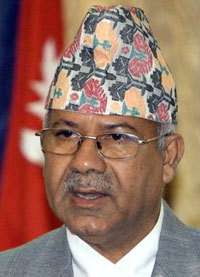 Nepalese Prime Minister Madhav Kumar Nepal. Nepalese Prime Minister Madhav Kumar Nepal.
Nepal’s new prime minister appealed May 26 for the Maoist party to join his government, saying the former rebels’ participation was needed to protect the country’s peace process.
Madhav Kumar Nepal was sworn in May 25 after three weeks of political deadlock triggered by the shock resignation of Maoist premier Prachanda only eight months after taking office.
Prachanda stepped down over a dispute with the national army, which he and his fellow guerrillas had fought against in a bloody civil war that ended in 2006.
“This is not the time to stop the path of consensus, reconciliation and unity,” the new prime minister said. “I appeal to the Maoists to join the present government and help in taking the peace process forward.”
Prachanda came to power in elections last year, but quit after a failed bid to sack the head of the army, General Rookmangud Katawal.
The Maoists have insisted that 19,000 of their former fighters be integrated into the ranks but the army has refused, saying the men can never become non-partisan soldiers.
|TOP|
Aussie Cops to Visit
In the wake of a series of attacks on Indian students in Australia, a police team will visit various cities in India to hold sessions on personal security with aspirants before they came here for education.
A multicultural liaison officer Vic Robb is flying with a team of Victoria University and Metropolitan Fire Brigade on a six-day tour, beginning from June 1. It will tour five cities, including Mumbai and New Delhi, an official statement of Victorian Police said May 26.
The students will be briefed on what to expect after arriving in Melbourne, and what support is available, it said.
“It’s important we speak to students prior to their departure as we want to ensure they take on board everything we are saying, and our messages do not get lost as a result of information overload, which can happen when they get here,” Robb said.
The sessions of the Victoria police will focus on safer living and crime prevention tips, role of police and Police Indian Western Reference Group besides, their right to feel safe, and knowing how and when to contact emergency services.
“Safety is one of the main priorities for international students travelling to Australia so we want this trip, combined with our proactive policing initiatives to ensure that they get most out of their time here,” Robb said.
|TOP|
|
|
|
|
|
|